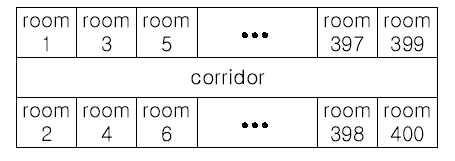| Time Limit: 1000MS | Memory Limit: 10000K | |
| Total Submissions: 20479 | Accepted: 6717 |
Description

The floor has 200 rooms each on the north side and south side along the corridor. Recently the Company made a plan to reform its system. The reform includes moving a lot of tables between rooms. Because the corridor is narrow and all the tables are big, only one table can pass through the corridor. Some plan is needed to make the moving efficient. The manager figured out the following plan: Moving a table from a room to another room can be done within 10 minutes. When moving a table from room i to room j, the part of the corridor between the front of room i and the front of room j is used. So, during each 10 minutes, several moving between two rooms not sharing the same part of the corridor will be done simultaneously. To make it clear the manager illustrated the possible cases and impossible cases of simultaneous moving.

For each room, at most one table will be either moved in or moved out. Now, the manager seeks out a method to minimize the time to move all the tables. Your job is to write a program to solve the manager's problem.
Input
Each of the following N lines contains two positive integers s and t, representing that a table is to move from room number s to room number t each room number appears at most once in the N lines). From the 3 + N -rd
line, the remaining test cases are listed in the same manner as above.
Output
Sample Input
3 4 10 20 30 40 50 60 70 80 2 1 3 2 200 3 10 100 20 80 30 50
Sample Output
10 20 30
Source
这题就是给你N个区间,求出最多不想交的区间数
#include <iostream>
#include <string.h>
#include <stdio.h>
#include <algorithm>
using namespace std;
struct node
{
int s,t;
};
node gd[203];
node re[203];
bool cmp(const node &a,const node &b)
{
if(a.s==b.s)
return a.t<b.t;
return a.s<b.s;
}
int main()
{
int T,n;
int s,t;
int i,j,k;
scanf("%d",&T);
while(T--)
{
scanf("%d",&n);
for(i=0;i<n;i++)
{
scanf("%d%d",&s,&t);
if(s%2==0) s--;//奇偶相差一算是一个区间段的,应为是对称着的
if(t%2==0) t--;
gd[i].s=s<t?s:t;
gd[i].t=s>t?s:t;
}
sort(gd,gd+n,cmp);
memset(re,0,sizeof(re));
for(k=i=0;i<n;i++)
{
j=0;
while(gd[i].s<=re[j].t)//这是因为奇偶算是一个区间段,所以这里才有等号
{
j++;
}
re[j]=gd[i];
if(j>k)
k=j;
}
k++;
printf("%d\n",k*10);
}
return 0;
}